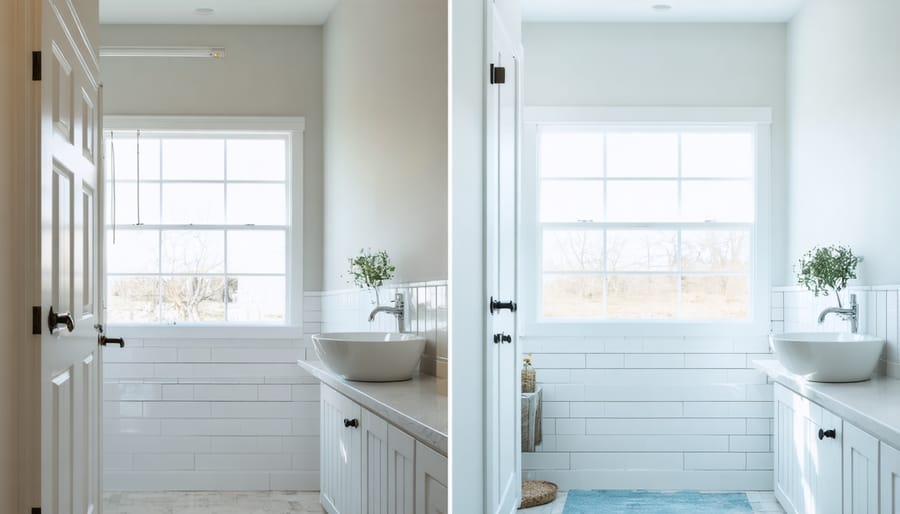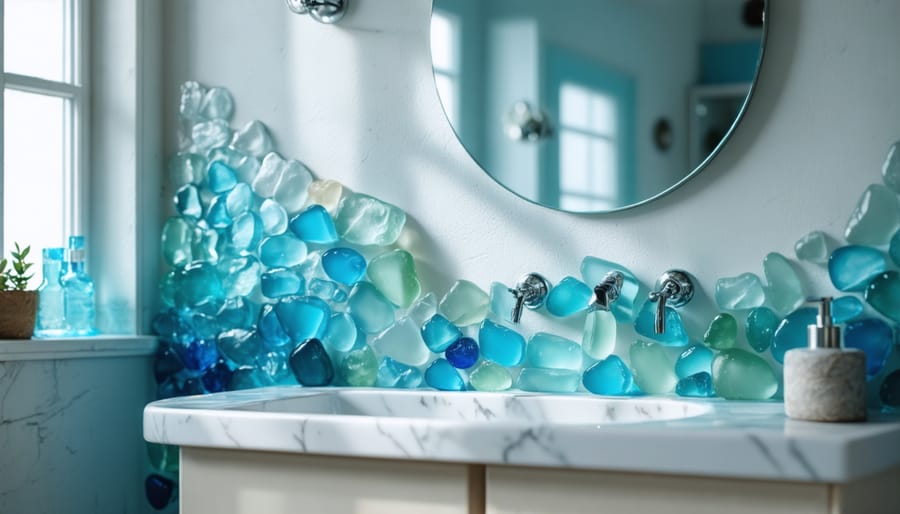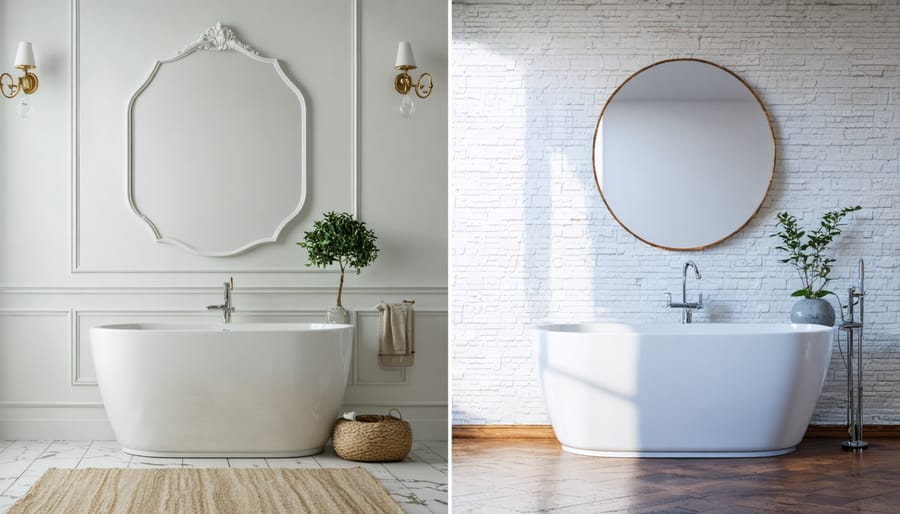Transform your cramped bathroom into an airy sanctuary with strategic color choices that make your room look bigger. Soft whites like Benjamin Moore’s “Cloud White” create an illusion of expanded space while bouncing natural light throughout the room. Cool-toned pale grays and gentle blues, such as Sherwin-Williams’ “Sea Salt,” draw the eye upward and establish a sense of depth without overwhelming the limited square footage. For a modern twist, consider light sage green or pale blush pink – these unexpected choices add personality while maintaining an open, breathable atmosphere. When selecting your paint, opt for moisture-resistant, satin, or semi-gloss finishes that withstand bathroom humidity while adding a subtle reflective quality that enhances the space-expanding effect of your chosen color.
Light and Airy: The Classic Winners
Crisp Whites and Off-Whites
White paint remains a timeless choice for small bathrooms, and for good reason. Pure whites and soft off-whites can help brighten any north-facing room, making them particularly effective in compact spaces. Benjamin Moore’s “White Dove” offers a warm, welcoming tone that reflects light beautifully without feeling stark or clinical. For those seeking something slightly softer, “Swiss Coffee” provides a gentle off-white that creates depth while maintaining an airy feel.
When choosing whites, consider your bathroom’s lighting. Natural light lovers should opt for pure whites like Sherwin-Williams’ “Extra White,” which maximizes light reflection. If your bathroom relies on artificial lighting, creamy whites like “Alabaster” can prevent the space from feeling too harsh or sterile.
The key to success with white paint lies in the finish you choose. A semi-gloss finish not only stands up well to moisture but also helps bounce light around the room, creating the illusion of more space. For optimal results, pair your white walls with white fixtures and tiles to create a seamless, spacious look that opens up even the tiniest bathroom.

Soft Grays and Greiges
Soft grays and greiges (a blend of gray and beige) offer a sophisticated solution for small bathrooms while maintaining an open, airy feel. These versatile neutrals create a sense of calm and provide an excellent backdrop for bathroom fixtures and decor. Light gray shades like Benjamin Moore’s “Gray Owl” or Sherwin-Williams’ “Repose Gray” reflect natural light beautifully, making your space feel larger and more inviting.
For a modern twist, consider warmer greige options such as “Agreeable Gray” or “Edgecomb Gray,” which bring subtle warmth while maintaining the spacious feeling that lighter colors provide. These hybrid hues work particularly well in bathrooms with limited natural light, as they don’t feel as stark as pure grays.
Pro tip: To maximize the impact of these colors, pair them with white trim and fixtures. This combination creates subtle contrast that defines the space without overwhelming it. Consider using semi-gloss or satin finishes in these shades, as they stand up well to moisture while helping to bounce light around the room. For added interest, incorporate metallic accessories in chrome or brushed nickel to complement these sophisticated neutrals.
Unexpected Colors That Actually Work
Pale Blues and Sea Glass Tones
When it comes to creating an airy, expansive feel in a small bathroom, pale blues and sea glass tones work wonders by channeling the boundless depths of ocean waters. These nature-inspired hues, ranging from soft aqua to gentle seafoam green, can make your walls appear to recede, instantly creating the illusion of more space.
Light blue-gray shades, reminiscent of morning mist over the ocean, are particularly effective at brightening dark corners while maintaining a sophisticated appearance. Consider paint colors like Benjamin Moore’s “Glass Slipper” or Sherwin-Williams’ “Sea Salt” for a perfect balance of cool serenity and space-enhancing properties.
Sea glass tones, with their frosted, translucent quality, bring a unique dimension to small bathrooms. These colors work exceptionally well in spaces with natural light, as they shift and shimmer throughout the day, much like their namesake beach treasures. Pair these watery hues with white fixtures and chrome finishes to amplify their space-expanding effects.
Pro tip: To maximize the impact of these colors, carry the same shade onto the ceiling. This technique eliminates the harsh line between wall and ceiling, creating a continuous flow that makes the room feel taller and more open. For best results, choose a paint with a slight sheen to reflect light and enhance the water-inspired ambiance.

Soft Sage and Muted Greens
When it comes to creating a serene, spa-like atmosphere in your small bathroom, soft sage and muted greens are excellent choices that bring the calming essence of nature indoors. These gentle, earthy tones provide a perfect balance between color and neutrality, making your space feel both fresh and sophisticated.
Sage green, with its gray undertones, works particularly well in bathrooms with limited natural light, as it doesn’t darken the space like deeper greens might. For the most harmonious effect, opt for a sage shade that leans slightly warm – this will help maintain a welcoming atmosphere while preventing the room from feeling too cool or clinical.
Pair these gentle greens with white trim and fixtures to create definition and prevent the space from feeling too monochromatic. Natural elements like wooden accents or woven baskets complement these colors beautifully, enhancing the organic feel of your bathroom.
Pro tip: Consider using a paint with a satin or semi-gloss finish in these soft green shades. Not only will this help with moisture resistance, but it will also reflect light more effectively, making your small bathroom feel airier and more spacious. For added depth, try painting the ceiling a lighter tint of your chosen green – this subtle touch can create a cohesive look without overwhelming the space.
Remember that lighting plays a crucial role in how these colors appear, so test your chosen shade under both natural and artificial lighting before committing to the entire room.
Color Application Strategies
Monochromatic vs. Accent Walls
When it comes to painting a small bathroom, you’ll need to decide between two popular approaches: going monochromatic or creating an accent wall. Both strategies can work wonders, but they serve different purposes in spatial perception.
A monochromatic scheme, using a single color throughout the space, creates a seamless look that can make your bathroom feel larger and more cohesive. This approach works particularly well in very small bathrooms where multiple colors might feel choppy or overwhelming. Consider using different sheens of the same color to add subtle depth – for instance, a matte finish on walls with semi-gloss on trim.
On the flip side, an accent wall can add personality and visual interest to your space. The key is choosing the right wall: typically, the one behind your vanity or toilet works best as a focal point. When going this route, keep the other walls neutral and complementary. For example, if you’re brave enough to try a deep navy accent wall, pair it with soft gray or warm white on the remaining surfaces.
For those worried about committing to either approach, here’s a pro tip: start with a monochromatic scheme and test out the accent wall idea using removable wallpaper or temporary decals. This allows you to experiment without permanent commitment while getting a real feel for how the contrast affects your space.

Coordinating with Fixtures and Lighting
When selecting paint colors for your small bathroom, it’s crucial to consider how they’ll work with your existing fixtures and lighting. Start by taking inventory of your bathroom’s permanent elements, including the toilet, sink, tub, and tiles. The undertones in these fixtures – whether warm or cool – should guide your paint color selection.
For bathrooms with classic white porcelain fixtures, you have the most flexibility in color choice. However, if your fixtures have cream or beige undertones, stick to warmer paint colors to maintain harmony. Following basic color theory principles can help you create a cohesive look that ties everything together.
Lighting plays an equally important role. Natural daylight shows true colors, while artificial lighting can dramatically affect how paint appears. If your bathroom relies mainly on artificial light, test paint samples under your specific lighting conditions at different times of day. Cool-toned LED lights might make warm colors appear dull, while incandescent bulbs can make cool colors look slightly greenish.
Consider metallic fixtures too – chrome and nickel fixtures typically pair well with cool colors, while brass and bronze hardware looks stunning against warmer hues. If you’re working with existing colored tiles, choose a paint color that either complements them subtly or deliberately contrasts for a bold statement.
Remember to factor in your mirror’s reflection – it will double the visual impact of your chosen color, so ensure it’s one you’ll love seeing multiplied.
Choosing the perfect paint color for your small bathroom doesn’t have to be overwhelming. By following the guidelines we’ve discussed, you can transform your compact space into a welcoming oasis that feels spacious and serene. Remember that while light, neutral colors are traditionally safe choices, don’t be afraid to experiment with bolder options if they align with your personal style and the bathroom’s lighting conditions.
The key is to consider your bathroom’s unique characteristics – its natural light, fixture finishes, and overall style – when making your final color selection. Whether you opt for classic whites and creams, soothing blues and greens, or make a statement with darker hues, ensure your choice creates harmony with existing elements in the space.
Start with sample swatches and test them in different lighting conditions throughout the day. This small investment in time and effort can save you from costly mistakes and ensure you’ll be happy with your choice for years to come. Don’t forget that finish matters just as much as color – a satin or semi-gloss finish will help reflect light and stand up to moisture better than flat paint.
Most importantly, trust your instincts while keeping these design principles in mind. Your bathroom should reflect your personality while maintaining a sense of openness and tranquility. With the right paint color, even the smallest bathroom can become a stunning showcase of smart design choices and personal style. Take your time with the selection process, and don’t hesitate to adjust your choice if your first instinct doesn’t feel quite right. After all, paint is one of the most transformative and budget-friendly ways to revitalize any space.
